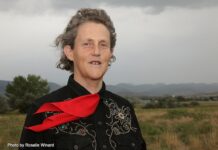WOOSTER, Ohio — The Buckeye Agricultural Museum and Education Center — a tribute to agricultural history across northeast Ohio — is taking form at 877 W. Old Lincoln Way, adjacent to the Wayne County Fairgrounds.
Team effort
The organizers, known as the Friends of the Wayne County Fair, are completing exhibits with hopes of having the 19,500 square-foot museum open this spring.

When visitors arrive, they’ll enter through a 35-foot concrete silo, into a large entry room that features original barn timbers and hand-hewn beams, donated from a private landowner who removed an historic barn south of Wooster.
The first room will house exhibits from the early period, from settlement to the Civil War. The second room will house exhibits from the Civil War Era to about World War II, and other rooms will house larger exhibits, including a 1923 Russell steam engine, made in Massillon, Ohio.
Farm buildings
The interior walls of the first two rooms have been renovated with rough-sawn timbers and wooden display shelves, to create a barn setting, and the second room features part of a corn crib. There are displays that feature wooden stanchions used for milking cows, and one featuring the pulley system used to stack hay and straw in barn lofts.
Additional large-scale exhibits include a McCormick pull-type combine, a Champion threshing machine made in Orrville, Ohio, and some reconstructed farm buildings, including a stand-alone granary, and an original log barn.
Paul Locher, a Wayne County historian and the museum’s curatorial adviser, said the goal is to “bring together a facility that will reflect the vanishing agricultural heritage of the northeast region of Ohio.”
Working together
The Friends of the Wayne County Fair is a local nonprofit, with a board that includes county fair board members and local historians. The Wayne County Fair will eventually own the building after the loan is paid off, but the museum is managed by a separate board.
According to Locher, the vision for the museum dates to the 1960s, when then Gov. Jim Rhodes and his administration were making plans for an ag museum to be located along U.S. 250, near the Ohio Agricultural Research and Development Center.
Those plans ultimately fell through due to a lack of funding, but Locher said some people have been saving things for the museum since that time.
Now, those historic artifacts have a home.
But the museum team is being selective about which items it chooses to exhibit. For starters, Locher said the artifacts need to be given to the museum, not loaned.
“We’re going to put a real accent on finding things that have a story with them, things that we know what families they came (from), what farms they were used on,” Locher said. “Because without the stories, it’s just stuff, and we’re trying to find stuff that has the stories.”
The artifacts will be displayed with a label, so visitors know what they’re looking at and its origin.

Ron Grosjean, a local farmer, collector and president of the group, said the museum will “show younger generations how hard our ancestors worked to make this country successful today.”
Ideal location
Grosjean said the number and sheer size of some of the donations — like the steam engine — made it necessary to find a building large enough to house and display the pieces.
The project is being supported by a number of cash donations, including a capital fund grant of $400,000 approved by the state legislature.
The state money was awarded last July, Locher said, with the stipulation that it be spent by the end of the year.
The deadline led to extensive end-of-year progress, including the construction of the entryway silo, exterior landscaping and parking areas, and major work on the interior woodwork and flooring.
Community and education
The museum also includes renovated meeting space, which local farm and community groups are already booking, and there are rooms dedicated to historic pictures, artwork and other memorabilia that tell the story of agriculture.
All of the rooms have a historical concept, including the restrooms, which have been renovated with hardwood lumber, and corrugated metal siding.
Local artist, Kristin Lorson, is designing murals that will capture history on the outside of some of the windows.
The museum continues to accept donations of artifacts and money, and, for the right amount, you can have a room named in your honor.
The museum has been open for the past two years during special events and by appointment, but organizers plan to have the first phase of the project open by spring. They expect additional growth in the years ahead.
“I think we’ll find out there’s even more history we didn’t know about, as people learn about this,” Grosjean said.
Learn more:
You can learn more about the Buckeye Agricultural Museum and Education Center on Facebook, by searching: Friends of the Wayne County Fair. You can also visit www.woosterhistory.org/exhibits/show/buckeyeagriculturalmuseum.
To make a donation or for more information about sponsorship, call Paul Locher at 330-264-6941, or Ron Grosjean at 330-466-8089.











There was a movement back in the 1970s to establish an Ohio Agricultural Museum back in the 1970s. I know because I wrote about it in Farm & Dairy back in then. See https://scontent.fmnl3-1.fna.fbcdn.net/v/t1.0-9/52717016_10218172001553290_1436835528820391936_n.jpg?_nc_cat=101&_nc_eui2=AeHvaCzep-wE_OPxGW2LygydNCO3IgvGvEvlbrOk9-vqZv8xApBCJZtJc2buwGiSr9C-51OGWocGPxjmm0MaX-604GDIm1472E87NT-6nxNZcA&_nc_ht=scontent.fmnl3-1.fna&oh=2e5105499fdddd5740bc2e9d9de00ff9&oe=5CE66938
I would love to read your article but it won’t open because it says the url expired.
Please repost if possible.